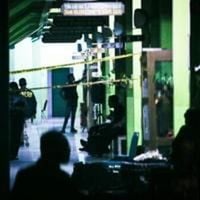On November 7, 2025, what should have been a peaceful Friday prayer at the mosque of SMAN 72—a state high school nestled inside a navy residential complex in Jakarta’s Kelapa Gading neighborhood—was shattered by two loud explosions. The blasts, which erupted just as the sermon began, sent gray smoke billowing through the mosque, prompting terrified worshipers to scramble for safety. In the immediate aftermath, the scale of the tragedy became clear: dozens were injured, some seriously, and a community was left reeling.
Initial reports from AFP and Bernama put the number of injured at 54, but as medical assessments continued, that figure climbed sharply. By November 9, police confirmed that 96 people had been hurt in the explosions, with many suffering burns and shrapnel wounds. Of these, 29 remained hospitalized across three medical facilities, with others receiving outpatient care. The victims included students, several of whom lost their hearing due to their proximity to the mosque’s loudspeaker—where the blasts are believed to have originated, according to Jakarta Police Chief Asep Edi Suheri, as cited by the Associated Press.
“Of the victims, 29 remain in hospitals in three locations, while the others have been discharged and continue outpatient treatment,” National Police Chief General Listyo Sigit Prabowo told reporters after visiting the wounded. The trauma of the incident, however, was not just physical. Recognizing the psychological toll, police and the Child Protection Commission announced plans to establish a trauma center to support the mental health of affected students. Sigit noted that despite the ordeal, many students were determined to return to school as soon as possible.
At the center of the investigation is a 17-year-old student at SMAN 72, who was among the injured and underwent surgery for head injuries. He remains under police guard in intensive care, but his condition is said to be improving. Authorities are hopeful that, once he recovers, he will be able to assist in the ongoing investigation. The suspect’s home yielded crucial evidence: investigators seized explosive powder and a collection of writings, as reported by AP. They also found a toy submachine gun inscribed with white supremacist slogans and the names of two neo-Nazis convicted of deadly attacks in Canada and Italy.
While the blasts were initially met with speculation about possible terrorist motivations, police have since ruled out a formal terrorist attack. However, they are not ruling out the possibility that others may have been involved. “We will not stop here. We will continue to investigate whether other individuals or groups were involved,” National Police Chief Sigit stated, emphasizing the thoroughness of the ongoing probe. The Densus 88 counter-terrorism unit has been brought in to investigate any potential links to terrorist networks, though, as of now, no such connections have been found.
The suspect’s motives remain under close scrutiny. According to local media reports referenced by AP and Bernama, the 12th-grade student had allegedly been the target of repeated bullying and may have sought revenge through what was intended as a suicide attack. Ridlwan Habib, an intelligence and terrorism analyst from the University of Indonesia, told AP, “This is the first time in Indonesia that an attack has occurred inside a school carried out by a 17-year-old student and the target was his own friends.” Habib suggested that the suspect may have been influenced by international extremists he encountered through internet searches, imitating their actions in a tragic act of retaliation.
Authorities are leaving no stone unturned. The investigation is examining all possible motives, including ideological influences, social media exposure, and the impact of bullying. The suspicious powder found at the suspect’s home is undergoing forensic analysis, and police have urged the public not to speculate while the facts are still being gathered. As Sigit put it, “His condition is gradually improving following intensive treatment, and he will assist in the investigations if required.”
The events at SMAN 72 have sent shockwaves through Indonesia, a nation that, while not immune to violence, has rarely seen such attacks perpetrated by students against their peers within a school setting. The attack has prompted soul-searching about the pressures faced by young people, the dangers of online radicalization, and the urgent need for stronger support systems within schools. The fact that the suspect reportedly sought to imitate international extremists has raised alarms about the global reach of hate-fueled ideologies and the vulnerabilities of youth exposed to such content online.
In the wake of the tragedy, the community has rallied to support the victims and their families. Police and school officials have worked to reassure parents and students, while mental health professionals prepare to offer counseling and trauma support. “The police, together with the Child Protection Commission, plan to set up a trauma centre to support their mental health,” Sigit explained, highlighting the importance of addressing both the immediate and long-term impacts of the attack.
As the investigation continues, authorities are keenly aware of the delicate balance between transparency and the need to avoid fueling further panic or speculation. The Densus 88 unit’s involvement underscores the seriousness with which the case is being treated, even as officials stress that no evidence of organized terrorist involvement has been found so far. The recovery of the toy submachine gun with extremist slogans and references to neo-Nazi attackers abroad is a chilling reminder of how global currents of hate can find their way into local tragedies.
For Indonesia, the attack at SMAN 72 is a painful first—a stark warning about the risks of unchecked bullying, the perils of online radicalization, and the importance of vigilance in protecting young people. As the wounded heal and the investigation unfolds, the nation is left to grapple with hard questions about how to prevent such tragedies in the future and how to support those left in their wake.
In the days ahead, the focus will remain on the victims and their recovery, both physical and emotional. The hope is that, with community support and a thorough investigation, SMAN 72 and the wider Jakarta community can begin to heal from a day that changed so many lives in an instant.





